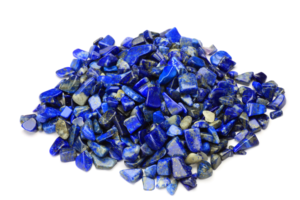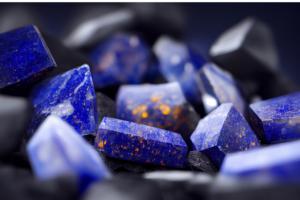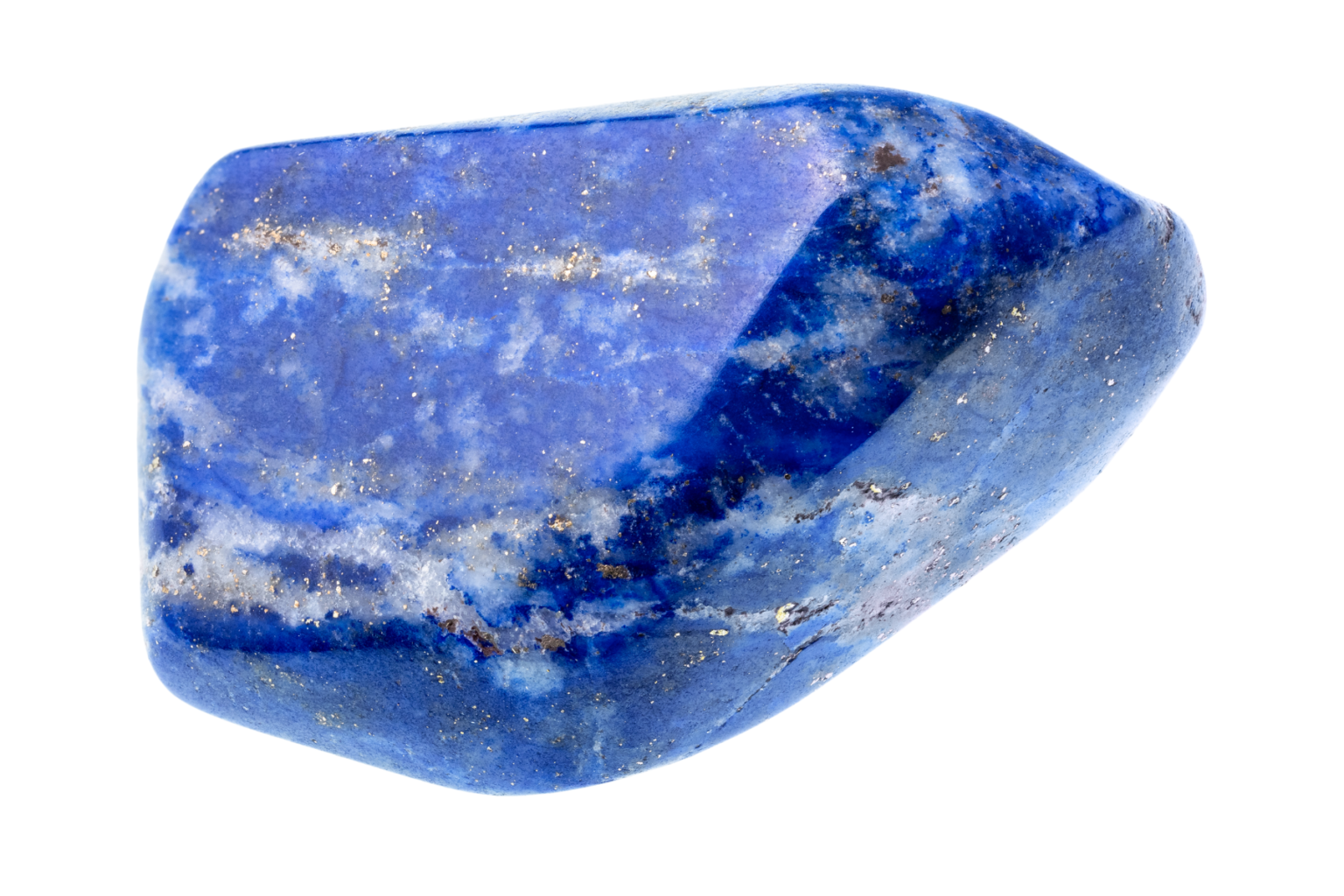What is lapis lazuli?
Lapis lazuli is a deep blue-colored gemstone that has been prized for its beauty and rarity for thousands of years. It is a metamorphic rock composed mainly of the mineral lazurite, along with other minerals such as pyrite, calcite, and sodalite. Lapis lazuli has been used for various purposes throughout history, including as a decorative material in jewelry, as a pigment in painting, and as a healing stone in traditional medicine. It is still highly valued today for its striking blue color and unique pattern of gold-colored flecks and veins. Lapis lazuli is found in several locations around the world, including Afghanistan, Chile, Russia, and the United States.
What does lapis lazuli look like?
Lapis lazuli typically has a deep blue color, often with some variation in shade ranging from a pale blue to a very dark blue. It can also have white, gray, or gold-colored streaks or veins running through it, which are caused by the presence of other minerals such as calcite, pyrite, and/or sodalite. The gold-colored flecks or specks in lapis lazuli are typically pyrite, which is a metallic mineral that gives the stone a unique and distinctive appearance. Lapis lazuli is typically opaque, meaning that it does not allow light to pass through it, but it may have some translucency in thinner sections. Overall, lapis lazuli is a striking and beautiful gemstone with a distinctive appearance.
The Chakra of Lapis Lazuli
In traditional Hindu and Buddhist belief systems, there are seven chakras or energy centers in the body that are associated with specific colors and stones. The chakra associated with lapis lazuli is the throat chakra, which is located at the base of the throat.
The throat chakra is associated with communication, self-expression, and the ability to speak one’s truth. Lapis lazuli is believed to help balance and activate this chakra, promoting clear and effective communication, as well as enhancing creativity and self-expression. It is also believed to have a calming effect on the mind, helping to alleviate stress and anxiety, and to promote mental clarity and focus.
Physical Benefits
Lapis lazuli is believed to have physical healing properties that can help with a variety of health conditions. Here are some of the commonly associated physical benefits of lapis lazuli:
- Respiratory health: Lapis lazuli is associated with the respiratory system and is believed to help alleviate respiratory problems such as asthma, bronchitis, and pneumonia.
- Thyroid health: Lapis lazuli is believed to have a positive effect on the thyroid gland, which plays a crucial role in regulating metabolism and energy levels.
- Headaches and migraines: Lapis lazuli is believed to help alleviate headaches and migraines by promoting relaxation and reducing stress.
- Immune system support: Lapis lazuli is believed to have a strengthening effect on the immune system, helping to protect the body against illness and infection.
- Pain relief: Lapis lazuli is believed to have analgesic properties, meaning that it can help to reduce pain and inflammation in the body.
Emotional Benefits
Lapis lazuli is believed to have a range of emotional benefits and can help to promote emotional healing and well-being. Here are some of the commonly associated emotional benefits of lapis lazuli:
- Spiritual growth: Lapis lazuli is believed to promote spiritual growth and self-awareness, helping individuals to connect with their higher selves and find meaning and purpose in life.
- Emotional healing: Lapis lazuli is believed to help release negative emotions such as anger, frustration, and sadness, promoting emotional healing and balance.
- Communication: Lapis lazuli is associated with the throat chakra and is believed to help improve communication skills, both verbal and written. It can also enhance self-expression and creativity.
- Mental clarity: Lapis lazuli is believed to help improve mental clarity and focus, promoting the ability to think and concentrate more effectively.
- Calming and stress-relief: Lapis lazuli is believed to have a calming effect on the mind and body, helping to alleviate stress and anxiety and promote a sense of peace and tranquility.
 Spiritual Benefits
Spiritual Benefits
Lapis lazuli is believed to have a range of spiritual benefits and can help to promote spiritual growth and well-being. Here are some of the commonly associated spiritual benefits of lapis lazuli:
- Intuition and inner wisdom: Lapis lazuli is believed to promote intuition and enhance access to inner wisdom, helping individuals to connect with their higher selves and access spiritual guidance.
- Awareness and consciousness: Lapis lazuli is believed to enhance awareness and consciousness, helping individuals to become more present and mindful in their daily lives.
- Meditation: Lapis lazuli is often used in meditation to promote mental clarity and focus, helping individuals to deepen their meditation practice and connect with their inner selves.
- Spiritual growth: Lapis lazuli is believed to promote spiritual growth and self-awareness, helping individuals to deepen their spiritual practice and develop a greater sense of purpose and meaning in life.
- Connection to the divine: Lapis lazuli is believed to promote a sense of connection to the divine and to higher realms of consciousness, helping individuals to access spiritual insights and experiences.
The History
Lapis lazuli has a long and rich history that dates back thousands of years. The gemstone was highly prized in many ancient civilizations, particularly in Egypt, Mesopotamia, and Persia.
In ancient Egypt, lapis lazuli was believed to have magical properties and was used in jewelry, art, and religious objects. The Egyptians believed that the gemstone could help protect the soul in the afterlife, and it was often included in burial tombs and sarcophagi.
In Mesopotamia, lapis lazuli was also highly valued for its beauty and rarity. It was used to create jewelry, amulets, and other decorative objects, and was often traded over long distances.
In Persia, lapis lazuli was known as “the blue stone” and was used to create intricate carvings, jewelry, and decorative objects. The Persians believed that the gemstone could protect against evil and bring good luck.
Lapis lazuli also played an important role in the art and culture of ancient Greece and Rome. It was used to create ornamental objects, jewelry, and vases, and was often ground into a fine powder and used as a pigment in paintings.
In the Middle Ages, lapis lazuli was highly valued by artists for its bright blue color, and was often used in illuminated manuscripts and paintings. It continued to be used in art and decorative objects throughout the Renaissance and into the modern era.
Today, lapis lazuli is still highly prized for its beauty and rarity, and is used in a variety of applicat
ions including jewelry, sculpture, and decorative objects. Its rich history and cultural significance continue to make it a beloved gemstone around the world.
Lapis Lazuli in Contemporary Jewelry
Today, lapis lazuli is still highly prized for its beauty and rarity and is used in a variety of contemporary jewelry designs. It can be used in a range of jewelry designs, from simple stud earrings to ornate necklaces and bracelets. Lapis lazuli is often paired with gold or silver settings, which complement the stone’s natural beauty.

One of the most common uses of lapis lazuli in jewelry is in the form of cabochons, which are smooth, polished stones that have a convex surface and a flat back. Cabochons can be set in a variety of jewelry designs, including rings, pendants, and earrings. Lapis lazuli is also often carved into intricate shapes and designs, such as beads, cameos, and figurines, which can be used in necklaces, bracelets, and other types of jewelry.
Lapis Lazuli Care
Lapis lazuli is a relatively soft gemstone, with a Mohs hardness of 5 to 6, which makes it vulnerable to scratches and chips. To protect the stone and ensure its longevity, it is important to handle lapis lazuli jewelry with care and avoid exposing it to harsh chemicals or extreme temperatures.
Cleansing and Recharging Lapis Lazuli
Like any gemstone, lapis lazuli can absorb negative or stagnant energy over time. To restore the stone’s natural balance, it is recommended to cleanse and recharge it regularly. Lapis lazuli can be cleansed by holding it under running water, placing it in sunlight or moonlight, or smudging it with sage or palo santo.
In conclusion, lapis lazuli is a gemstone with a rich history and distinctive beauty that continues to be prized by jewelry designers today. Whether set in a simple cabochon or carved into an intricate shape, lapis lazuli’s deep blue color and gold-colored flecks make it a striking and memorable addition to any piece of jewelry. With proper care and regular cleansing, lapis lazuli jewelry can be enjoyed for years to come.

Summary
Lapis lazuli is a gemstone that has been prized for thousands of years for its distinctive deep blue color and gold-colored flecks. It has been used in jewelry, art, and religious objects by many ancient civilizations, including Egypt, Mesopotamia, and Persia. In contemporary jewelry, lapis lazuli is often used in cabochons, carvings, and beads, and is paired with gold or silver settings. Lapis lazuli is believed to have physical, emotional, and spiritual benefits, including promoting respiratory and thyroid health, releasing negative emotions, improving communication and mental clarity, and promoting spiritual growth and awareness.

